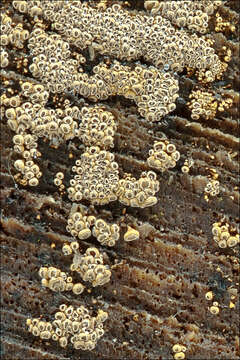Merismodes-anomala_6

Description:
Merismodes anomala, syn.: Cyphellopsis anomala, Persoon: Fries 1821, Cyphellopsis confuse, (Bresadola 1903) Reid 1964, Solenia stipata, Fuckel 1870 DE Rasigs HngebecherchnSlo.: ?Dat.: Jan. 09. 2014Lat.: 46.35979 Long.: 13.70464Code: Bot_780/2014_DSC9714Habitat: Path side surrounded by pastures and mixed wood, near a farm house, locally flat terrain on southeast oriented mountain slope, open place, however, because of mountain ridges only about two hours of sun per day in winter months; mixed overgrown old scree and alluvial deposits, calcareous ground, exposed to direct rain, average precipitations ~ 3.000 mm/year, average temperature 7-9 deg C, elevation 560 m (1.850 feet), alpine phytogeographical region.Substratum: on cut-off surface of three felled down Juglans regia trunks in its initial disintegration stage.Place: Lower Trenta valley, near abandoned farm house Skokar, Trenta 2, between villages Soa and Trenta, right bank of river Soa, East Julian Alps, Posoje, Slovenia EC Comments: I initially thought these tiny mushrooms were ascomycete cup fungi. However, under the microscope, the species turned out to be a rather peculiar, cup-shaped basidiomycete. It had been thriving almost the whole January 2014 (the warmest ever measured in Slovenia!) on these logs. The species is not present in the Slovenian fungi check list (Ref.: 1). This surprises because it has been recorded in all surrounding countries and is not considered a very rare one. Surprises also the substratum found. Ref.: 2. states 39 different species of hardwood, however, Juglans regia is not among them. The logs were infected with Ascocorine sarcodes, Trametes sp, and Exidia sp. too.Taxonomy of this genus (syn.: Cyphellopsis / Solenia) seems not yet fixed. Several mycologists agree that it is almost impossible to distinguish among many described species in it. It has already been a member of several genera. In addition, some DNA analysis doesn't support presently supposed morphological division into species and speaks more in the direction of a 'cloud' of highly variable forms probably representing a genus, which is in a vigorous (micro)evolutionary process (Ref.:2). Strange enough, its closely related to gilled mushrooms and is placed in the family Niaceae, which includes, hard believing, salt-water-inhabiting fungi (Ref.:7.). The whole taxonomy story is nicely described in Ref. 5.Spores smooth. Dimensions: 8.8 [9.7 ; 10.1] 11 x 4.5 [5 ; 5.2] 5.7 microns, Q = 1.7 [1.9 ; 2] 2.2 ; N = 25 ; C = 95%, Me = 9.9 x 5.1 microns ; Qe = 1.9. Asci dimensions: 28.7 [38.7 ; 47.9] 57.9 x 4.6 [5.5 ; 6.3] 7.2 microns, Q = 6.2 [7 ; 7.7] 8.4 ; N = 10 ; C = 95%, Me = 43.3 x 5.9 microns, Qe = 7.3. Olympus CH20 NEA 100x/1.25, magnification 1.000 x, oil (spores); NEA 40x/0.65, magnification 400x (asci, hairs), in water. AmScope MA500 digital camera.Herbarium: Mycotheca and lichen herbarium (LJU-Li) of Slovenian Forestry Institute, Vena pot 2, Ljubljana, Index Herbariorum LJFRef.:(1) A. Poler, ed., Seznam gliv Slovenije (in Slovene), 2nd Ed., Assoc. of Mycol. Soc. of Slovenia (1998).(2) G.J. Krieglsteiner (Hrsg.), Die Grosspilze Baden-Wrttembergs, Band 3., Ulmer (2001), p 601.(3) S. Buczacki, Collins Fungi Guide, Collins (2012), p 394.(4) www.britmycolsoc.org.uk/files/2113/0209/2479/PFRN%20Newsl... (5) www.psms.org/sporeprints/SP464.pdf (6) www.mycobank.org/BioloMICS.aspx?Link=T&TableKey=14682... (7) P. Bodensteiner, M. Binder, JM. Moncalvo, R. Agerer and D.S. Hibbett, Phylogenetic relationships of cyphelloid homobasidiomycetes, Mole. Phylogenetics and Evol. (2004), 30 : 115. available at www.clarku.edu/faculty/dhibbett/Reprints%20PDFs/Bodenstei...
Source Information
- license
- cc-by-nc-sa
- copyright
- Amadej Trnkoczy
- photographer
- Amadej Trnkoczy
- original
- original media file
- visit source
- partner site
- Flickr Group
- ID


